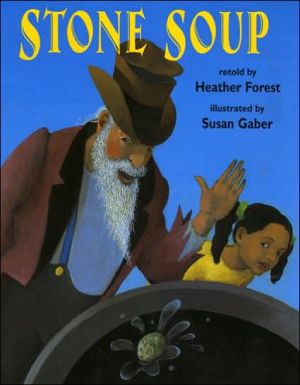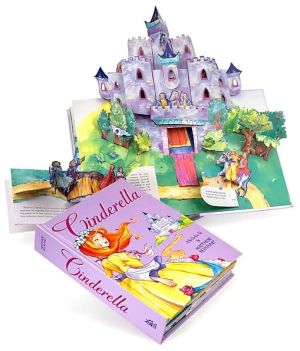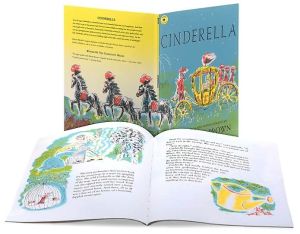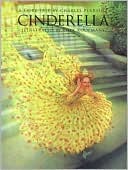Stone Soup
Two hungry travelers arrive at a village expecting to find a household that will share a bit of food, as has been the custom along their journey. To their surprise, villager after villager refuses to share, each one closing the door with a bang. As they sit to rest beside a well, one of the travelers observes that if the townspeople have no food to share, they must be in greater need than we are.\ \ \ Two hungry travelers use a stone as a soup starter and demonstrate...
Search in google:
Two hungry travelers arrive at a village expecting to find a household that will share a bit of food, as has been the custom along their journey. To their surprise, villager after villager refuses to share, each one closing the door with a bang. As they sit to rest beside a well, one of the travelers observes that if the townspeople have no food to share, they must be in greater need than we are.Publishers WeeklyForest and Gaber (previously paired for The Woman Who Flummoxed the Fairies; The Baker's Dozen) revisit this oft-told tale to demonstrate the pleasures of collaboration and mutual generosity. Two hungry travelers, denied food by the inhabitants of a mountain village, publicly declare that they can make soup from a stone. Only they need a carrot... and a potato... and a few more ingredients to make it taste really good. Everyone in the town contributes something, pronounces the soup delicious and learns the magic behind it: sharing. Gaber's bold acrylic paintings emphasize the big black soup tureen and the brightly colored vegetable ingredients. As each member of the multiracial town speaks up to offer a contribution, a speech bubble appears showing a picture of the offering. Forest's jolly prose simmers with energy: "Bring what you've got! Put it in the pot!" cry the travelers. Flavorful and nutritious, this classic tale is served up with a smile. A recipe for stone soup tops it off. Ages 4-8. (May) FYI: The other two folktales in the series are The Dancing Turtle: A Folktale from Brazil, retold by Pleasant DeSpain, illus. by David Boston; and a bilingual title, The Girl Who Wore Too Much: A Folktale from Thailand, retold by Margaret Read MacDonald, trans. by Supaporn Vathanaprida, illus. by Yvonne Lebrun Davis (each $15.95 ISBN -502-X; -503-8; May)
\ Publishers Weekly\ - Publisher's Weekly\ Forest and Gaber (previously paired for The Woman Who Flummoxed the Fairies; The Baker's Dozen) revisit this oft-told tale to demonstrate the pleasures of collaboration and mutual generosity. Two hungry travelers, denied food by the inhabitants of a mountain village, publicly declare that they can make soup from a stone. Only they need a carrot... and a potato... and a few more ingredients to make it taste really good. Everyone in the town contributes something, pronounces the soup delicious and learns the magic behind it: sharing. Gaber's bold acrylic paintings emphasize the big black soup tureen and the brightly colored vegetable ingredients. As each member of the multiracial town speaks up to offer a contribution, a speech bubble appears showing a picture of the offering. Forest's jolly prose simmers with energy: "Bring what you've got! Put it in the pot!" cry the travelers. Flavorful and nutritious, this classic tale is served up with a smile. A recipe for stone soup tops it off. Ages 4-8. (May) FYI: The other two folktales in the series are The Dancing Turtle: A Folktale from Brazil, retold by Pleasant DeSpain, illus. by David Boston; and a bilingual title, The Girl Who Wore Too Much: A Folktale from Thailand, retold by Margaret Read MacDonald, trans. by Supaporn Vathanaprida, illus. by Yvonne Lebrun Davis (each $15.95 ISBN -502-X; -503-8; May)\ \ \ \ \ School Library JournalPreS-Gr 1As they did in The Baker's Dozen 1993 and The Woman Who Flummoxed the Fairies 1990, both Harcourt, this storyteller and illustrator have once again collaborated in the retelling of a traditional tale. Unlike Marcia Brown's classic version in which three hungry French soldiers are returning from a war Scribners, 1947, this Stone Soup is not linked to any particular time or place. The straightforward, didactic retelling concludes with the lesson for those readers who somehow missed it: "`These two travelers made such a delicious soup out of a stone.' `Out of a stone,' said the travelers with a grin, `and a magical ingredient...sharing.'" Gaber's brilliantly colored paintings illuminate a mountain village with a multicultural population. Whereas Brown's version offers readers a tasty mix of suspicious peasants and clever soldiers, Forest's tale has a medicinal aftertaste.Kathleen Whalin, Greenwich Country Day School, CT\ \




